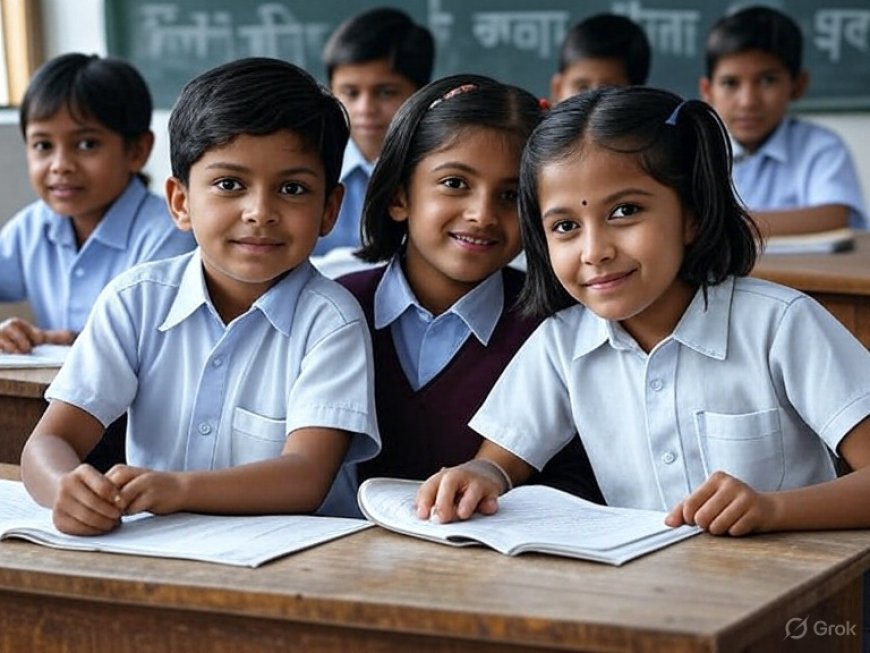Hindi No Longer Mandatory in Maharashtra Schools: New Language Policy Sparks Statewide Debate
Maharashtra removes Hindi as a compulsory subject in schools, giving students more language choices. Explore the policy’s impact, political reactions, and national implications.

In a landmark policy shift that has reignited the debate around language, education, and regional identity, the Maharashtra State Education Department has announced that Hindi will no longer be a compulsory subject in non-Hindi medium schools. The decision, rolled out as part of a broader revision of the state's education policy, makes Hindi optional from Class 6 onwards, allowing students to choose from a wider array of third-language options.
This reform is being seen as a significant move toward linguistic autonomy and educational flexibility, especially in a culturally diverse state like Maharashtra. However, the announcement has also triggered mixed reactions across political, academic, and parental circles.
What the Policy Change Means
Until now, Hindi was a mandatory third language in most government and private schools in Maharashtra that followed the State Board (SSC) curriculum. Under the three-language formula mandated by the National Education Policy (NEP) 1986, students typically studied:
-
Marathi (as the first language),
-
English (as the second), and
-
Hindi (as the third).
With the new directive, students will now be allowed to choose their third language, which could include Sanskrit, German, French, or even regional languages like Gujarati, Telugu, or Kannada, depending on school availability and preference.
According to The Indian Express, the circular issued by the Maharashtra School Education Department emphasized “language freedom and cultural inclusivity” as guiding principles behind the change.
State Government's Perspective
Maharashtra’s Education Minister Deepak Kesarkar defended the decision, stating that the new rule aligns with the National Education Policy 2020, which emphasizes multilingualism without imposing any single language.
“We are not against Hindi. But in a multilingual and multicultural state like Maharashtra, students should be free to learn languages based on their aspirations and family backgrounds,” Kesarkar told reporters in Mumbai.
This change also reflects a broader pushback against perceived impositions of Hindi across non-Hindi speaking states. States like Tamil Nadu, Kerala, and West Bengal have long resisted Hindi dominance in education, and Maharashtra now joins that growing list.
For a deeper look at the linguistic policies in Indian states, refer to PRS Legislative Research.
Political Reactions: Support and Dissent
The Shiv Sena (UBT) and NCP factions welcomed the decision, calling it a long-overdue correction. They stressed that language should never become a tool of cultural centralization, especially in a federal democracy.
Conversely, leaders from the Bharatiya Janata Party (BJP) criticized the move, arguing that it could weaken national unity and disadvantage students when they step into central competitive exams where Hindi often plays a role.
Union Minister Nitin Gadkari, who hails from Nagpur, took a balanced stance, stating that while mother tongues must be prioritized, students should still be encouraged to learn Hindi as a valuable link language.
Impact on Students, Teachers, and Schools
Students and Parents
Many urban parents have welcomed the change, especially in cosmopolitan areas like Mumbai, Pune, and Thane, where children often already study foreign languages or regional Indian languages at home. The flexibility will allow students to focus on languages that align with career goals, such as French or German for those aiming for international studies.
Teachers
However, Hindi language teachers have expressed concern over possible job insecurity. The Maharashtra Teachers’ Federation has asked for retraining and redeployment programs to help affected teachers transition to teaching other subjects.
Schools
Private schools affiliated with ICSE and CBSE boards are likely to face fewer disruptions, as these boards already offer multiple third-language options. But state board schools, especially in rural areas, may take time to adjust due to shortage of trained faculty in alternative languages.
National Context: Language, Identity, and Autonomy
This policy change in Maharashtra cannot be viewed in isolation. It feeds into the larger national discourse on linguistic diversity vs linguistic imposition.
The central government has often been accused of promoting a “one nation, one language” narrative through its push for Hindi in administration, signage, and education. This has led to protests in several southern and northeastern states, with calls to uphold the federal spirit of India’s Constitution, which recognizes 22 official languages under the Eighth Schedule.
A relevant analysis on The Hindu explores how language has become a political tool in recent years, and why education policy must tread carefully in a country with such rich linguistic plurality.
Legal and Constitutional Framework
The Right to Education Act (2009) does not mandate any specific language in curriculum design, leaving it to states to decide. Similarly, the Kothari Commission (1964–66) and the National Education Policy 2020 promote the idea of linguistic freedom and cultural integration without enforcing Hindi or any other language.
As per Article 350A of the Constitution, states are obligated to provide facilities for the instruction of children in their mother tongue, which makes the Maharashtra government’s decision constitutionally sound.
What’s Next?
While the implementation will be gradual, beginning with Class 6 from the 2025–26 academic year, the policy has the potential to:
-
Encourage linguistic diversity in classrooms,
-
Give students greater autonomy in choosing languages,
-
Reduce the academic burden of studying multiple compulsory languages,
-
Reinforce the role of Marathi as the cultural backbone of the state.
However, effective rollout will require:
-
Teacher training programs,
-
Adequate resource material in other Indian and foreign languages,
-
Curriculum coordination with national boards and universities.
Conclusion
Maharashtra’s decision to make Hindi optional marks a bold departure from decades of linguistic orthodoxy in Indian education. It opens the door to more inclusive, student-centric learning that respects regional identity and cultural diversity, without undermining national integration.
As the education landscape continues to evolve, this reform could serve as a model for other multilingual states, striking a fine balance between choice and cohesion.











